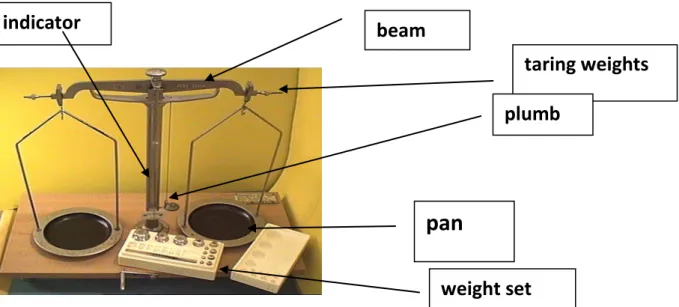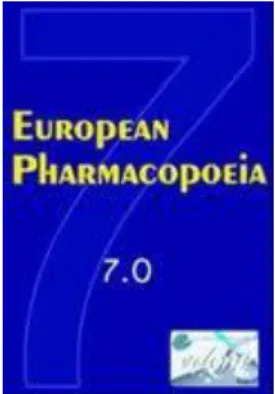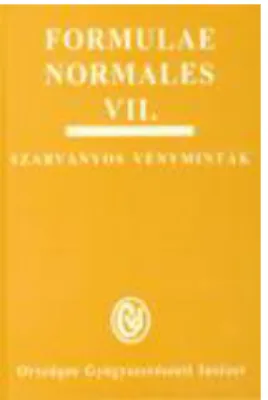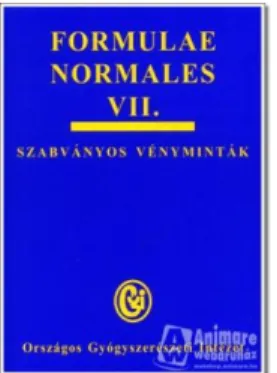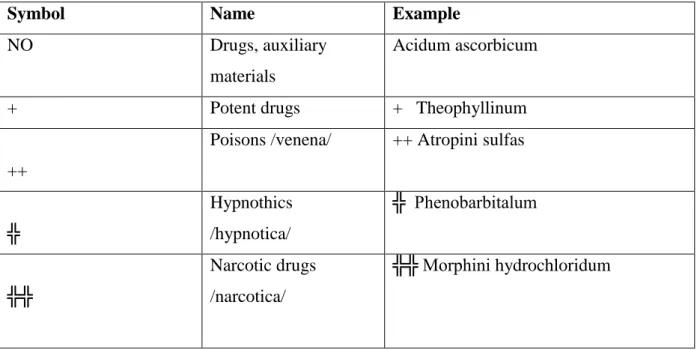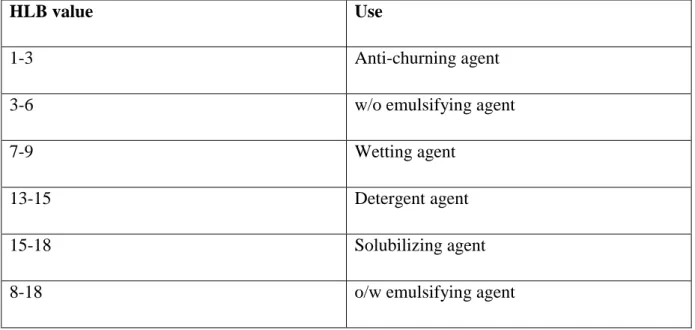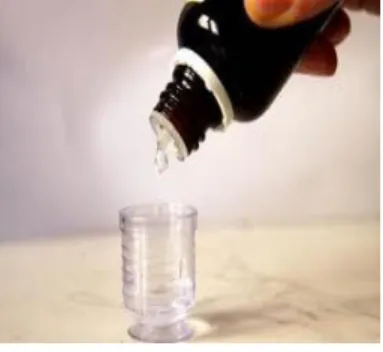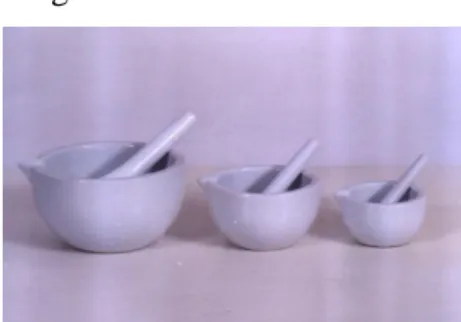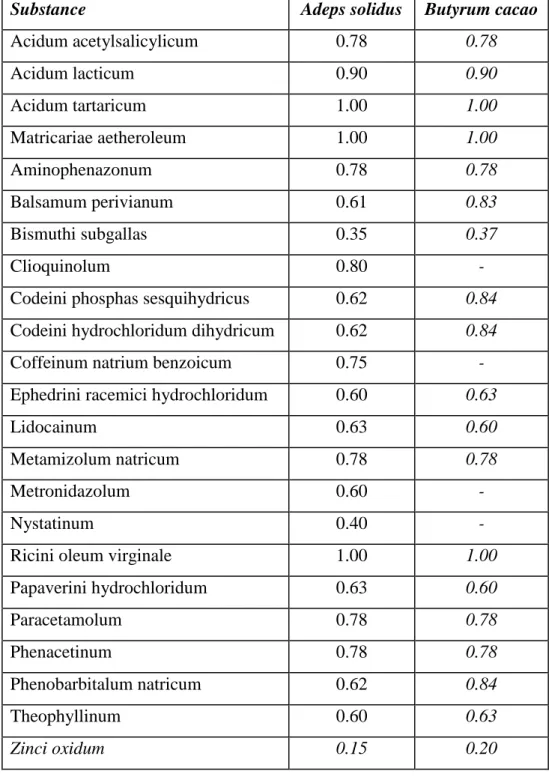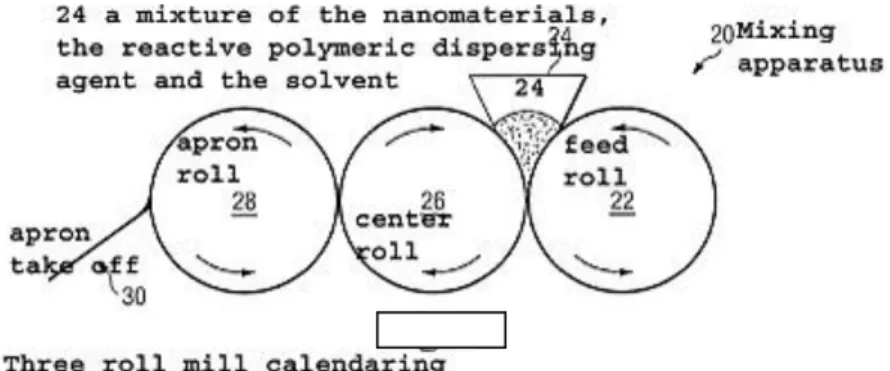1
Department of Pharmaceutical Technology Medical and Science Center
University of Debrecen
„Practicals in Pharmaceutical Technology - Prescription Pharmacy”
By,
Miklós Vecsernyés Ildikó Bácskay
Ferenc Fenyvesi Judit Váradi Pálma Fehér
Supervised by,
Géza Regdon Jr.
Éva Regdon
Debrecen
2011
2
Table of contents
Pharmaceutical Latin 8
Latin declension 8
Numerals 10
Examples of the use of declinable numerals 11
Ordinal numbers 12
The use of prepositions 12
Reading of per cent (%) 13
Pharmaceutical prescriptions 13
Selection and use of weighing and pharmacy balances 21
Technical books of pharmacy 25
Dose calculation of oral liquid preparations 32
Example for interpolation 33
‘Papaverine’ solution (magistral prescription) 36 Liquid preparations for oral use (Preparationes liquidate peroraliae) 37
Solutions (Solutiones) 38
Solutio ad salivam /FoNo VII./ 43
Solutio Castellani sine fuchsino /FoNo VII./ 44
Solutio contra rhagades mamillae /FoNo VII./ 45
Solutio metronidazoli /FoNo VII./ 45
Solutio nephrolytica /FoNo VII./ 46
Solutio noraminophenazoni pro parvulo /FoNoVII./ 47
Solutio pepsini /FoNo VII./ 47
Solutio theophyllini /FoNo VII./ 48
Spiritus iodosalicylatus /FoNo VII./ 48
Glycerinum boraxatum /FoNo VII./ 49
Syrups (Sirupos) 50
Sirupus zinci /FoNo VII./ 51
Elixirs (Elixiria). 52
3
Tinctures (Tincturae) 52
Aromatic waters, concentrated aromatic waters (Diluenda). 52
Diluendum menthae /FoNo VII./ 53
Solubilization 54
Gargles (Gargarismae) 57
Gargarisma antiseptica /FoNo VII./. 58
Gargarisma chlorogeni /FoNo VII./ 58
Drops for oral administration (Guttae) 59
Dose calculation of oral drops 60
Gutta aethylmorphini /FoNo VII./ 60
Gutta expectorans composita /FoNo VII./ 62
Ear drops (Otoguttae, Auristillae) 62
Otogutta borica /FoNo VII./. 63
Otogutta hydrogencarbonici /FoNo VII./. 64
Nasal drops (Nasoguttae) 65
Nasogutta zinci cum ephedrino /FoNo VI./. 67
Nasogutta ephedrini 1% /FoNo VII./ 67
Nasogutta ephedrini pro infante /FoNo VII./. 68
Decoctions and infusions (Decocta et Infusa). 68
Infusum ipecacuanhae pro parvulo /FoNo VII./ 69
Enemas (Klysmae) 70
Klysma chlorali pro infante /FoNo VII./ 72
Mixtures (Mixturae) 73
Mixtura pectoralis /FoNo VII./ 73
Suspensions ( Suspensiones ) 74
Suspensio anaesthetica /FoNo VII./ 77
Suspensio bismogeli /FoNo VII./. 78
Suspensio nystatini /FoNo VII./. 79
Suspensio siccans /FoNo VII./ 80
Suspensio terpini /FoNo VII./ 81
Emulsions (Emulsiones) . 82
4
Emulsio olei ricini /FoNo VII./. 85
Emulsio paraffini cum phenolphthaleino /FoNo VII./ 86
Liniments (Linimenta) 87
Linimentum ad pernionem /FoNo VII./. 87
Linimentum scabicidum /FoNo VII./. 88
Rectal preparations (Rectalia) 89
Suppositories (Suppositoria). 89
Suppositorium ad nodum /FoNo VII./ 105
Suppositorium analgeticum forte /FoNo VII./ 106 Suppositorium antispastica pro parvulo /FoNo VI./ 107 Suppositorium antipyreticum pro parvulo /FoNo VII./ 108
Suppositorium laxans /FoNo VII./. 109
Suppositorium noraminophenazoni 100 mg /FoNo VII./ 110 Suppositorium noraminophenazoni 200 mg /FoNo VII./ 111 Suppositorium noraminophenazoni 500 mg /FoNo VII./ 112 Suppositorium papaverini pro parvulo /FoNo VII./. 113 Suppositorium spasmolyticum /FoNo VII./ 114
Vaginal preparations (Vaginalia) 115
Globulus metronidazoli compositus /FoNo VII./ 116 Globulus zinci sulfurici (magistral preparation). 117
Ovulum nystatini /FoNo VII./ 118
Semi-solid preparations for cutaneous application. 119
Ointments (Unguenta) 120
Unguentum ad vulnera /FoNo VII./. 132
Unguentum anaestheticum /FoNo VII./. 133
5
Unguentum antirheumaticum /FoNo VII./ 134
Unguentum antisepticum /FoNo VII./ 135
Unguentum boraxatum cum aqua calcis /FoNo VII./. 135
Unguentum carbamidi /FoNo VII./. 136
Unguentum contra dolorem /FoNo VI./ 137
Unguentum contra rhagades mamillae /FoNo VII./. 137
Unguentum contra rheumam /FoNo VII./. 138
Unguentum dermophylicum /FoNo VII./ 139
Unguentum haemorrhoidale /FoNo VII./. 140
Unguentum ichthyolsalicylatum /FoNo VII./. 141
Unguentum infantum /FoNo VII./... 141
Unguentum nasale /FoNo VII./. 142
Unguentum neonatorum /FoNo VII./. 143
Unguentum nutritivum /FoNo VII./. 144
Unguentum nystatini /FoNo VII./ 145
Unguentum refrigerans /FoNo VII./.. 146
Unguentum salicylatum 1% /FoNo VII./ 147
Unguentum salicylatum 3% /FoNo VII./ .147
Unguentum salicylatum 5% /FoNo VII./ 148
Unguentum salicylatum 10% /FoNo VII./. 148 Official pastes in the Hungarian Pharmacopoeia 149
Pasta zinci oxydati /Ph.Hg.VII./ . 149
Pasta zinci oxydati oleosa /Ph.Hg.VII./. 149 Pasta zinci oxydati salicylata /Ph.Hg.VII./. 150
6
Official pastes in the Hungarian standardized prescriptions (FoNo VII.) 151
Pasta antirheumatica /FoNo VII./ 151
Pasta contra solarem /FoNo VII./ 152
Pasta Boraxata /FoNo VII./.. 152
Pasta Burowi /FoNo VII./ 153
Creams (Cremores). 154
Cremor aquosus /FoNo VII./.. 155
Cremor erythromycini /FoNo VII./ 156
Cremor refrigerans /FoNo VII./. 156
Hand cream. 157
Oily face and body cream for night. 158
Gels 159
Unguentum silicoparaffini /FoNo VI./ 159
Unguentum antirheumaticum /FoNo VI./ 160
Diclofenac gel (BASF Generic Drug Formulation) 161
Powders (Pulveres) 162
Oral powders (Pulveres perorales).. 163
Undivided powders 170
Pulvis aluminii et magnesii /FoNo VII./ 170
Pulvis antacidus /FoNo VII./. 170
Pulvis Caroli /FoNo VII./. 171
Divided powders 172
Pulvis antidoloricus /FoNo VII./. 172
Pulvis asthmalyticus fortis (modified prescription). 173
Pulvis combinatus /FoNo VII./. 174
7
Pulvis paracetamoli cum codeino /FoNo VII./ 175
Pulvis spasmalgeticus /FoNo VII./. 176
Talc powders (Dusting powders, Sparsoria) 177
Sparsorium antisudoricum /FoNo VII./ 178
Sparsorium contra pruritum /FoNo VII./ 179
Sparsorium infantum /FoNo VII./ 180
Dehydration – Oral rehydration treatment.. 181
Sal ad rehydrationem /FoNo VII./. 182
Sal ad rehydrationem pro parvulo /FoNo VII./ 183
Incompatibilities. 184
Prescription 1 184
Prescription 2. 185
Prescription 3. 186
Prescription 4. 187
Prescription 5 188
Prescription 6. 189
Materials knowledge.. 190
Calculations 252
Alligation. 252
Exercises for concentration calculations. 257
Appendices 258
Latin abbreviations commonly used in prescriptions
and in the course of pharmacy work. 258
Frequent synonyms of pharmaceutical substances 263
Bibliography 274
8
Pharmaceutical Latin
Latin Declension
The nouns in Latin are declined according to five declensions.
To the first declension belong the nouns whose root ends in –a and their genitive in –ae.
These are mostly nouns of feminine gender.
Latin words Meanings Accusative Genitive Plural accusative millilitra millilitre millilitram millilitrae millilitras
gutta drop guttam guttae guttas
capsula capsule capsulam capsulae capsulas
tabletta tablet tablettam tablettae tablettas
ampulla ampoule ampullam ampullae ampullas
To the second declension belong the nouns ending in –us, er, ir, um in the nominative singular. Their genitive singular always ends in –i. Aside from a few exceptions, those ending in –us, -er, ir are of masculine, those ending in –um always of neutral gender.
Latin words Meanings Accusative Genitive Plural accusative
alcoholum alcohol alcoholum alcoholi alcohola
decoctum decoction decoctum decocti decocta
unguentum ointment unguentum unguenti unguenta
sirupus syrup sirupum sirupi sirupos
suppositorium suppository suppositorium suppositorii suppositoria
tubus tube tubum tubi tubos
9
To the third declension belong words with various nominative singular endings and whose root ends in a consonant or –i. Their genitive singular is always –is.
Latin words Meanings Accusative Genitive Plural accusative
infans infant infantem infantis infants
solutio solution solutionem solutionis solutions
pulvis powder pulverem pulveris pulveres
pars part partem partis partes
dosis dose dosim dosis doses
Both of the two undermentioned declensions are rare in pharmaceutical sciences.
To the fourth declension belong those u-stem words whose nominative singular ending is – us and genitive singular ending is also –us. These nouns are of masculine gender, those ending in –u in the nominative singular are of neutral gender.
Latin words Meanings Accusative Genitive Plural accusative
usus use usum usus usus
spiritus alcohol spiritum spiritus spiritus
To the fifth declension belong nouns with an e-stem. Their nominative singular ends in –es, their genitive in –i.
Latin words Meanings Accusative Genitive Plural accusative
res thing rem rei res
species tea mixture speciem speciei species
10 Numerals
On the prescription the cardinal numerals are put in the accusative. As the numerical data usually refer to grams, dosage, drops, etc., the declinable numerals must agree with the noun qualified. Most often grams are indicated on prescriptions. The following is a specific example:
Singular Plural
Nominative gramma grammata
Accusative gramma grammata (the accusative is written on the prescription)
Genitive grammatis grammatum
Dative grammati grammatibus
Ablative grammate grammatibus
Latin numerals 1 = unus, -a, -um 2 = duo, -ae, -o 3 = tres, tres, tria 4 = quattuor 5 = quinque 6 = sex 7 = septem 8 = octo 9 = novem
10 = decem 11 = undecim 12 = duodecim 13 = tredecim 14 = quattuordecim 15 = quindecim 16 = sedecim 17 = septemdecim 18 = duodeviginti
11 19 = undeviginti
20 = viginti 30 = triginta 40 = quadraginta 50 = quinquaginta 60 = sexaginta 70 = septuaginta 80 = octoginta 90 = nonaginta 100 = centum
200 = ducenti, -ae, -a
300 = trecenti, -ae, -a 400 = quadringenti, -ae, -a 500 = quingenti, -ae, -a 600 = sescenti, -ae, -a 700 = septingenti, -ae, -a 800 = octingenti, -ae, -a 900 = nongenti, -ae, -a 1000 = mille
2000 = duo milia 10000 = decem milia
1553 = mille quingenta quinquaginta tria
Examples of the use of declinable numerals Recipe (take thou)
gramma unum take 1 gram grammata duo take 2 grams grammata tria take 3 grams Recipe (take thou)
dosim unam take 1 dose doses duas take 2 doses doses tres take 3 doses Recipe (take thou)
12 tubum unum take 1 tube
tubos duos take 2 tubes tubos tres take 3 tubes Ordinal numbers
They occur relatively rarely. All of them as attributive adjectives have 3 forms for three genders.
first = primus, prima, primum second = secundus3
third = tertius3 fourth= quartus3 fifth = quintus3 sixth= sextus3 seventh= septimus3
eight=octavus3 ninth= nonus3 tenth= decimus3 eleventh= undecimus3 twentieth= vicesimus3 hundredth=centesimus3
e.g.:
Pharmacopoeia Hungarica Octava (Eight Hungarian Pharmacopoeia) The use of prepositions
Prepositions are widely used for prescription writing.
There are some often used prepositions in this table:
Preposition in Latin
Preposition in English
Case Examples Meaning
ad for accusative ad usum for use
contra against accusative contra dolorem against pain
per through accusative per rectum through the
rectum
in into accusative in vitrum into a bottle
13
in in ablative in vitro in a bottle
sine without ablative sine scatula without a box
sub under ablative sub signo veneni dispense under
the sign of poison
e, ex out of ablative e grammate uno out of one gram
pro for ablative pro infante for an infant
cum with ablative cum tinctura with tincture
Reading of per cent (%)
The indication of the concentration beside the name of many medications is indispensable.
The percentage (% = per centum) is formed as follows:
Solutio acidi borici 2% (duo per centum)
Acidum chloratum dilutum 10% (decem per centum)
Phenylhydrargyrum boricum solutum 0.1% (decem partes centesimae per centum) decem partes centesimae = ten hundredths (0.10)
Pharmaceutical prescriptions
What is a prescription?
A prescription is the instruction given by a physician, dentist or veterinarian to a pharmacist.
Who may prescribe?
Which drug classes must be prescribed?
It includes directions to the pharmacist regarding the preparation and dispensing of medicinal substances, and to the patient regarding the use of the medicine.
14 The practice of prescribing and the form in which it is done are subject to both legal controls and professional traditions.
Rational prescription
Make a specific diagnosis
Consider the pathophysiology of the diagnosis selected Select a specific therapeutic objective
Select a drug
Determine the appropriate dosing regimen
Devise a plan for monitoring the drug’s action and determine an end point for the therapy
Plan a program of patient education
Form of a prescription
A prescription may be written in ink or printed.
The language of a prescription may be the mother tongue of some country.
In the case of Hungarian prescriptions the official language is Latin.
Construction of the prescription
Date: The date must appear on every prescription.
Patient’s name, age and address: The full name and address of the patient must be written on every prescription. It is very important to know the patient’s age to calculate the dose of the prescribed medicine (single dose and daily dose), especially for children.
15 Inscription: The sign Rp (Recipe, take thou) introduces the body of the prescription in which the name of drug (or drugs) and the dosage are stated. In the case of precompounded tablets or capsules, the single dose is stated after the name of the drug. To prescribe precompounded orally administered liquids it is necessary to know the concentration of the active ingredients in the preparation.
Subscription: The subscription section contains directions to the pharmacist. In most cases this is limited to the number of tablets or capsules, package of the ordered preparation, or the total volume of a liquid preparation to be dispensed. This part also includes the physician’s signature and stamp.
Signature (Label): The signature of the prescription consists of instructions to the patient, via the pharmacist, and is preceded by the word „Label”. Latin abbreviations are often used here to save space.
Refill instruction (It is not used in Hungary because every prescription is ordered just for one occasion, and the medicines may not be repeated): Refill instructions should be indicated on every prescription (in Canada, in the USA). Controlled drugs (in Hungary „strong-effective drugs” marked with +) may not be repeated unless the practitioner orders the number of times and interval between refilling in writing, or the pharmacist contacts the prescriber directly each time a repeat is requested.
Narcotic preparations must not be repeated.
Prescriber’s signature: Every prescription must be signed and stamped by the prescriber (in Hungary just by the physician, in the UK by the physician and the nurse). The prescriber’s name, address, telephone number, licence number must appear at the top of the prescription.
It is very important because in Hungary the prescription is a document towards National Health Insurance.
The patient has to sign his/her name at the bottom of the prescription.
16 Typical problems with prescriptions
Inappropriate or inadequate refill directions.
Examples of inappropriate directions include too many refills.
Omission of information necessary for dispensing the prescription.
It is a very serious mistake because from 1995, with a view to GPP (Good Pharmacy Practice), the pharmacist has to tell the patient about the application and other directions.
How does the patient have to take the drugs?
How many times do the drugs have to be taken?
Before or after meals or between meals?
The pharmacist also has to inform the patient about the drug’s effects and side-effects.
Duration of the therapy.
The purpose of the medication.
Do not give an instruction like „Take as instructed”, because both the physician and the pharmacist must explain the instruction in detail to each patient.
Patient noncompliance and ambiguous information given by the pharmacist or the physician are the major causes of treatment failure.
Inadequate directions for use.
When the information is not appropriate or ambiguous. If it is possible, give the patient written information, not verbal information.
Unclear form of the prescription
If the physicians’ handwriting is illegible, the pharmacist has to call him/her and ask for directions of use.
17 Causes of patient noncompliance
1. The patient fails to obtain the medication.
2. The patient fails to take the medication as prescribed.
3. The patient prematurely discontinues the medication.
4. The patient takes the medication inappropriately.
Rules for prescription writing
1. Writing and reading prescriptions are inseparable from each other.
2. On the prescriptions the names of the medicaments are put in the genitive case, the quantities in the accusative.
3. The names of the medicaments may be simple (Ichthammolum), or compounded of 2- 4 words (Cera alba, Vaselinum album ophthalmicum).
4. The adjective qualifying the noun must agree with the noun in gender, number and case.
5. In the case of medicaments marked with a cross, the quantity must be written in letters and numbers, and it must be put in the accusative.
6. The quantity must be written in parentheses and always in grams.
7. The sign „g” is written before the quantity.
8. The quantities of mass have to be written in Arabic numerals, the number of drops and pieces in Roman numerals.
9. In the case of quantities of mass, the decimal point must be used even if after the decimal point we write 0 – tenth gram. For the sake of clarity, the quantities should always be underlined.
18 Rp.,
Codeini hydrochloridi dihydrici centigrammata decem (g 0.10) Metamizoli natrici
grammata duo (g 2.00) Saccharimidi natrici
tablettas duas (II) Aquae purificatae
ad grammata centum (ad g 100.0) (97.7 g) Misce fiat solutio
Detur: ad vitrum fuscum
Signetur: Take 5 ml 5 times a day.
Rp.,
Acidi borici Tannini
aa gramma unum et centigrammata quinquaginta (aa g 1.50) Glyceroli
grammata tria (g 3.00) Unguenti hydrophylici anionici
ad grammata viginti quinque (ad g 25.00) (19.0 g) Misce fiat unguentum
19 Detur: ad tubum vel ad fictile
Signetur: For external use only. Ointment.
Rp.
Pulveris combinati
FoNo dosim N° I (unam) Misce fiat pulvis
Detur: ad capsulas ceratas et ad scatulam Signetur: Take 1 powder 3 times daily.
Rp.
Solutionis pepsini
FoNo doses N° II (duas) Misce fiat solutio
Detur: ad vitrum fuscum
Signetur: 15 ml is diluted in 100.0 ml tap water. Drink it before meals.
20 Ordering of divided dosage forms
1. The physician gives the composition of one portion (one suppository, one powder, etc.) listing the ingredients one after the other, and finally gives the number of e. g.
suppositories or powders. This is a single-dose form.
In this case the subscription reads as follows:
Dentur tales doses N°. ...
2. The physician orders the multiplied dose of the ingredients and finally gives the number of portions into which this quantity is to be divided. This is a „multiple-dose form”. The subscription in this case reads as follows:
Example for suppositories:
Vehiculi
quantum satis ut fiant suppositoria N°….
Example for powders:
Divide in doses aequales N°……
21
Selection and use of weighing and pharmacy balances
Weighing
The medications can be prepared accurately according to the required norms and prescriptions if we weigh the specified mass quantities of the materials, that is if we carry out mass measurements.
The unit of measure for mass in the International System of Units /SI/ is the kilogram (kg). The Ph.Hg.VIII. uses the thousandth part of the kilogram, the gram (g). Depending on the mass to be measured, fractions of the gram denoted by prefixes, such as the milligram (mg) and the microgram (μg), can also be used. The Ph.Hg.VIII. does not use the centigram unit (cg), but its use in the practice of pharmacies is permitted.
Conversion for weights:
100 10 100 10 1000 1000 1000
kg > dkg > g > cg > mg > µg > ng > pg
Metric measures of weight 1 kg = 100 dkg
1 dkg = 10 g 1 g = 100 cg 1 cg = 10 mg 1 mg = 1000 μg 1 μg = 1000 ng 1 ng = 1000 pg
In measuring mass we compare with the help of a balance the mass of the material to be measured with the known mass of measuring bodies which are members of a set of weights.
In the pharmacy only sufficiently accurate balances and weigh sets satisfying the Hungarian standards can be used. In selecting balances, the aim is that the mass to be measured should be measurable conveniently and with the required accuracy. Balances and weights have to be certified at regular intervals.
22 Pharmacy balances
General principles for weighing and measuring
To prepare accurate dosage forms, pharmacists and pharmacy technicians must use weighing and measuring apparatus with care and understanding and must be conscious of the following general principles:
• Select weighing equipment and measuring devices appropriate for the intended purpose.
• Use the devices and operate the equipment with recommended techniques that ensure accuracy of measurement.
• Maintain the equipment so that it is clean and free of chemical contamination and retains the prescribed tolerances.
• Keep the equipment in a horizontal position.
In selecting the proper balance for use in compounding, pharmacists need to be familiar with the following terms:
Sensitivity: the smallest weight that gives a perceptible change in the indicating element, e.g.
one subdivision deflection of the indicator pointer on the index plate of the balance, or on the digital display of an electronic balance.
Accuracy: the closeness of the displayed weight, as measured by the balance, to the true weight, as known by the use of a calibration weight or weights.
Capacity: the minimum and maximum weight, including containers and tares, that can be placed on a balance plan.
23 I. Counter balance
The counter balance (Figure 1) was the most commonly used balance before electronic balances. It works on the basis of the principle of the equal-arm lever. It is usually designed for 1-2 g minimal loading and for 1000 g, less often for 500 g maximal loading. The accuracy of measurement is 0.10 g.
Measuring with counter balance:
Look at the indicator that moves in front of the index plate scale fixed on the column.
When the balance is not loaded, the indicator must point to the middle line scale.
Place the weights on the left hand pan.
Place the substance to be measured on the right hand pan of the balance.
It is forbidden to put the material to be weighed directly into the pan of the balance.
If the substance to be measured is equal to the weight on the left hand pan of the balance, the indicator points to the middle line scale.
Figure 1: Parts of the counter balance
taring weights
pan beam
plumb indicator
weight set
24 II. Centigram Quick Balance
The centigram quick balance is an unequal-arm balance with constant leading. Its weighing range is between 0.05 g - 50.0 g. Its accuracy is 0.01 g.
Handling:
The balance is enclosed in a metal case and it rests on two adjustable feet in front and a pin at the back. The horizontal position is set by means of the screws of the adjustable feet and the circular level. Establishing the equilibrium position of the balance (adjustment of the zero point) is done with the plastic knob over the arresting knob.
The rules of weighing:
It is important to keep the cup of the balance clean. Before weighing, it must be cleaned of mechanical impurities (dust). After weighing the different substances, it must be wiped with a small piece of paper or with a soft cloth. In weighing we can put the substance directly into the cup of the balance, but it is advisable to place coloured, smelly or sticky materials on cellophane.
It is shown on the optical scale how many centigrams are measured. One division of the scale corresponds to 1 cg (0.01 g). /The scale is from 1- 100/. If we measure more than 1 g /100 cg/, we have to take off the weights from the balance.
III. Electronic balance
Electronic balances /Figure 2/ are very accurate and can be used easily. The weighing range and the sensitivity of the balances can be different. It is forbidden to put the material to be weighed directly into the pan of the balance.
Procedure for weighing on an electronic balance:
• Position the balance on a flat, level surface in an area that is away from drafts or air currents.
• Turn the balance on, the digital display should show 0.000 g
• Place the weighing paper, dish or bottle etc. on the balance pan.
• Press the tare button, the digital display should show 0.000 g
• Add the material to be weighed until the desired weight appears on the digital display.
25
• If any powder or liquid was inadvertently spilled on the balance pan, clean the balance.
Figure 2: Electronic balance
Technical books of pharmacy
Pharmacopoeias
The word pharmacopoeia derives from Ancient Greek from pharmaco-'drug', followed by the verb-stem poie- 'make' and finally the abstract noun ending -ia. These three elements together can be rendered as 'drug-mak-ing'. In its modern technical sense, it is a book containing a list of medical substances, it contains directions for the identification of samples and the preparation of compound medicines, and published by the authority of a government or a medical or pharmaceutical society. The pharmacopoeia is an essential reference for all individuals and organisations involved in: pharmaceutical research, development, manufacture and testing. The pharmacopoeias are generally the official standards for the control and qualification of drugs.
26 Hungarian Pharmacopoeia
The Latin name for the Hungarian Pharmacopoeia is Pharmacopoeia Hungarica /Ph.Hg./. The Hungarian Pharmacopoeia is a departmental order, signed by the Minister of Health, it is for the regulation of the quality, control and qualification of drugs. Ph.Hg.VII. was official from 1987 to 2008. Ph.Hg.VIII., which is the translation of the European Pharmacopoeia, was published in 2003, and it has been valid from 2006. We still use some parts of Editio septima as well. Ph.Hg.VII. has 4 volumes.
The 4 volumes of Ph.Hg.VII.:
Volume I contains:
Introduction
List of monographs official in Ph.Hg.VII.
List of monographs included in Ph.Hg.VI. but not in Ph.Hg.VII.
Principles
General information and regulations
Tests and assays
Pharmaceuticals
Reagents Volume II contains:
Chemical substances in alphabetical order
Every chemical substance has its description, this contains:
Official Latin and Hungarian name
Chemical structure
Properties of the substance
(colour, odour, taste)
Solubility of the substance
Tests, investigations
Storage
Incompatibility
Usual dosing
27 Volume III contains:
Essential oils
Vegetable drugs
Pharmaceutical preparations
Radioactive pharmaceuticals
Serobacteriological preparations for human and for veterinary use
Blood preparations
Surgical dressings and sutures
Volume IV contains:
Tables of Ph.Hg.VII.
Table of drop number of some liquids
Drop number: how many drops may be produced from 1g of the liquid
Three tables for dosing For adults
For children up to 15 years old For veterinary dosing
In these tables mostly those substances are found that are marked with (a) full or empty cross(es) /
+,++
, ╬ , ╬╬ /Each substance has its maximal and usual doses.
Maximal single and daily doses and usual singe and daily doses
Table for the atomic weight of the elements
Table for the dilution of alcohol
Tables for the density-concentration for some substances
Tables for the preparation of sterile products
Graphs that help in the preparation of isotonic solutions
28 Hungarian Pharmacopoeia VIII. /Ph.Hg.VIII./
The 8th edition of the Hungarian Pharmacopoeia has been official since 1st August, 2006.
Ph.Hg.VIII. is the translation of the European Pharmacopoeia, with 3 basic volumes up to now. Supplements will be published in the future with corrections, new methods, substances and standards. Certain parts and chapters of the former pharmacopoeia remained in effect even after Ph.Hg.VIII. came into force, mainly because of national characteristics (e.g. dose checking tables, galenic preparations, etc.)
The first volume contains:
Preface
Introduction
European Pharmacopoeia Commission
General chapters
General notices
Methods of analysis
Materials for containers and containers
Reagents
General texts
General monographs
Monographs on dosage forms The second volume contains:
Changes of general chapters and general monographs and monographs of the dosage forms according to the first volume
Monographs of the substances
Referential assay
The third volume (III/A, III/B) contains:
Contains changes, corrections, new methods, substances and standards
29 European Pharmacopoeia
The European Pharmacopoeia (Ph.Eur.) of the Council of Europe is a pharmacopoeia, listing a wide range of active substances and excipients used to prepare pharmaceutical products in Europe. It includes more than 2000 specific and general monographs, including various chemical substances, antibiotics, biological substances; Vaccines for human or veterinary use; Immunosera; Radiopharmaceutical preparations; Herbal drugs; Homoeopathic preparations and homoeopathic stocks. It also contains Dosage forms, General monographs, Materials and Containers, Sutures; 268 General methods with figures or chromatograms and 2210 reagents are described. The monographs give quality standards for all the main medicines used in Europe. All medicines sold in the 36 Member States of the European Pharmacopoeia must comply with these quality standards so that consumers have a guarantee for products obtained from pharmacies and other legal suppliers. The European Pharmacopoeia is developed by the European Directorate for the Quality of Medicines (EDQM) and is a part of the Council of Europe, Strasbourg, France.
The 7th edition of the European Pharmacopoeia /Figure 3/ was published in July 2010, it has been valid from 1January 2011. Since its 5th edition, the pharmacopoeia has been published in 2 volumes. Volume 1 contains general chapters and monographs (e.g. on dosage forms, methods of analysis, reagents), volume 2 contains all substance monographs. During runtime of current edition several supplements are published. The supplements contain corrections, new methods, substances and standards. Electronic versions are also available (CD-ROM and online version).
Figure 3: 7th edition of the European Pharmacopoeia
30 Formulae Normales VII.
The word Formulae Normales /abbreviated FoNo/ means: standardized prescriptions.
It is a collection of magistral prescriptions and contains directions for their use. The 7th edition of the FoNo has been official since 2003. Two editions of FoNo VII. are available, one for pharmacists and the other one for doctors.
In FoNo VII., after each prescription the following information is given:
• conditions relating to the compositions, preparations
• general information /dispensing/
• dosing /signature/
• packaging and labelling
• therapeutic effects, side-effects
• interactions
• description about the active agents
• expiry period
Pharmaceutical edition
In the pharmaceutical edition of FoNo VII. /Figure 4/ the prescriptions are in alphabetical order, so the pharmacists can find them easily.
The names of the ingredients of compounded preparations are given in Latin, in a nominative and unabbreviated form.
Figure 4 : The pharmaceutical edition of FoNo VII.
31 Medical edition
In the medical edition of FoNo VII. /Figure 5/ the preparations are listed on the basis of pharmacological categories. The prescriptions are written in Latin, according to the rules of prescription writing. The ingredients and the quantities are given in the genitive and in the accusative form, respectively. Both books are edited by OGYI /Országos Gyógyszerészeti Intézet: National Institute of Pharmacy/.
Figure 5: The medical edition of FoNo VII.
Formulae Normales Veterinariae IV.
The Formulae Normales Veterinariae /abbreviated FoNo Vet./ contains the standardized prescriptions for veterinary use. Edition IV. has been official since 2009.
The preparations in FoNo Vet IV. /Figure 6/ are listed on the basis of pharmacological categories.
Figure 6: Formulae Normales Veterinariae
32
Dose calculation of oral liquid preparations
The pharmacist has to check the dosage of the oral preparation prescribed by the doctor in order to avoid overdosing.
The pharmacist has to calculate the dose when the active agent is marked with (a) full or empty cross(es). Drugs are signed by symbols according to their therapeutic effect. /Table 1/
Symbol Name Example
NO Drugs, auxiliary
materials
Acidum ascorbicum
+ Potent drugs + Theophyllinum
++
Poisons /venena/ ++ Atropini sulfas
╬
Hypnothics /hypnotica/
╬ Phenobarbitalum
╬╬
Narcotic drugs /narcotica/
╬╬ Morphini hydrochloridum
Table 1: The symbols of drugs according to their therapeutic effect
The single and daily doses are calculated and then compared with the maximum single and daily doses indicated in the fourth volume of Ph.Hg.VII.
The liquid preparations taken orally can be dosed by volume or by drops.
Calculation of oral liquid preparations dosed by volume
Ph.Hg.VII. gives the following measures:
1 tablespoonful 15 ml
1 child’s spoonful 10 ml
1 teaspoonful 5 ml
The quantities given in ml must be calculated into mass so that the dosage can be checked.
33 In the case of aqueous solutions, the density should be taken as 1.0
(e.g. 10 ml solution equals 10 g)
The density of syrups should be taken as 1.3 (e.g. 10 ml solution equals 13 g)
If there is more than 50% syrup in the aqueous solution, the density can also be taken as 1.3 /syrup factor/.
The age of the patient is also very important. Ph.Hg.VII. contains dosing tables for adults and for children up to 15 years old. If the age of the children is not indicated in the table, the pharmacist uses interpolation.
Example for interpolation:
Age of the patient Maximum dose of Ph.Hg.VII.
Pro dosi Pro die
1 year 30 mg 100 mg
3 years 50 mg 150 mg
Single dose: pro dosi /How much the patient takes once./
Daily dose: pro die /How much the patient takes during one day./
If the patient is 2 years old, we need the following calculation, which is called interpolation.
50 mg - 30 mg = 20 mg (20 mg for 2 years, which means 10 mg/year) 3 years - 1 year
30 mg + 10 mg = 40 mg /single maximum dose according to Ph.Hg.VII. for a 2-year-old child/
150 mg - 100 mg = 50 mg (50 mg for 2 years, which means 25 mg/year) 3 years - 1 year
34 100 mg + 25 mg = 125 mg /daily maximum dose according to Ph.Hg.VII.
for a 2-year-old child/
Age of the patient Maximum dose of Ph.Hg.VII.
Pro dosi Pro die
2 years 40 mg 125 mg
The daily dose is calculated from the frequency of administration, which is indicated in the labelling.
The pharmacist must always calculate with the more frequent ingestion.
The doctor can order in two ways:
……..times daily every……hours
In the case of an instruction saying 2-3 times daily, the pharmacist must calculate with 3 ingestions.
In the case of an instruction saying every 3-4 hours, supposing that the patient sleeps 8 hours, the calculation is the following:
24 – 8 = 16
16 / 3 = 5.3 the patient takes the medicine about 5 times daily 16 / 4 = 4 the patient takes the medicine 4 times daily
It means that we have to calculate with every 3 hours, because this will be the more frequent ingestion. According to the above calculation, administration every 3 hours would mean administration 5 times a day, but if we take into consideration that the patient takes the first dose in the morning and then one dose every 3 hours, administration 6 times a day will result.
It is possible to calculate both with administration 5 times or 6 times, but only one method can be used in one prescription.
35 At the end of the calculations it is practical to make a table.
Name and sign of the active agent………
Age of the patient Ordered dose Maximum dose of
Ph.Hg.VII.
pro dosi
pro die
Signature
It can be dispensed / It cannot be dispensed If there is overdosing, the doctor should be contacted.
The doctor may also order doses higher than the maximal doses of drugs marked with crosses.
In such cases the doctor must indicate with an exclamation mark, his sign manual and his stamp that the overdosing was intentional. If anything is missing from these and the pharmacist cannot contact the doctor, he/she should not prepare the medicine.
However, in case of urgency, the pharmacist has to reduce the quantity to the maximal dose according to Ph.Hg.VII.
e.g. Prescriptions with the remark “statim” or “cito” (immediately):
the medicine must be dispensed without delay.
36
‘Papaverine’ solution /magistral prescription/
Papaverini hydrochloridum 0.20 g
Sirupus aurantii 20.0 g
Aqua purificata ad 50.0 g (29.8 g) Label: In case of spasm, 5 ml maximum 5 times daily.
Preparation: Dissolve papaverine hydrochloride in warm distilled water and dilute with orange peel syrup.
Package: In a light-resistant bottle.
Expiry date: 1 month.
Action and use: Spasmolytic effect. It has to be prepared at the time of ordering.
Dose calculation:
50g → 0.20 g (density is 1, 1 teaspoonful is 5 ml) 5g → x
y = 5/ 50 X 0.20 = 0.02 g = 20 mg (single dose)
0.02 X 5 = 0.10 g = 100 mg (daily dose)
+ Papaverini hydrochloridum
1 year Ordered dose Maximum dose of
Ph.Hg.VII.
pro dosi 20 mg 40 mg
pro die 100 mg 120 mg
It can be dispensed (sign manual)
37
Liquid preparations for oral use (Preparationes liquidate peroraliae)
Definition (Ph. Eur. 7.0)
Liquid preparations for oral use are usually solutions, emulsions or suspensions containing one or more active substances in a suitable vehicle; they may, however, consist of liquid active substances used as such (oral liquids).
Some preparations for oral use are prepared by dilution of concentrated liquid preparations, or from powders or granules for the preparation of oral solutions or suspensions, for oral drops or for syrups, using a suitable vehicle.
Several categories of preparations may be distinguished by Ph. Eur. 7.0:
oral solutions, emulsions and suspensions
powders and granules for oral solutions and suspensions
oral drops
powders for oral drops
syrups
powders and granules for syrups
38
Solutions (Solutiones)
The solution as a drug formulation is a clear liquid free of sediment, prepared by dissolution of drugs and is intended for internal or topical use. (Ph.Hg.VII.)
Solutions can be made only from such drugs and in such concentration that:
• From the ready solution its ingredients should not separate out during the time of usability
• The properties of the ready solution should not change (colour, odour, etc.)
• Its ingredients should not decompose
Advantages and disadvantages of solutions
Advantages
Solutions are molecularly dispersed systems, they are completely homogenous, and they have the immediate availability for absorption and distribution.
Solutions also provide a flexible dosage form.
o they may be used by any route of administration
o they can be taken by or administered to patients who cannot swallow tablets or capsules
o doses are easily adjusted
Disadvantages
drugs and chemicals are less stable when in solution than when in dry, solid form
some drugs are not soluble in solvents that are acceptable for pharmaceutical use
drugs with objectionable taste require special additives or techniques to mask the taste when in solution
because solutions are bulkier and heavier than dry, solid dosage forms, they are more difficult to handle, package, transport and store
oral solutions in containers require measurement by the patient or caregiver. This is often less accurate than individual solid forms, such as tablets and capsules
39 Parts of the solution
• solute: dispersed medium
• solvent: dispersing medium
Mass percentage (%w/w)
In the solutions the dissolved materials are weighed and the solvent is added to the prescribed mass.
The solution is given in mass percentage: (%w/w) percent per weight.
This means the number of grams of solute per 100 g of solution.
What to consider during dissolution
• Heat sensitivity of the substances to be dissolved
• The nature of the substance
• The dissolved substance should not separate out from the solution prepared by heating, even after cooling to room temperature
The steps of dissolution
• Find the proper solvent
• Pour the solvent in the bottle (beaker etc..)
• Measure the substance to be dissolved on a balance
• Add the substance to be dissolved to the solvent
• Shake well until it dissolves
The order of dissolving
• If there is no significant difference in the solubility of the ingredients, we usually dissolve the ingredients according to their increasing masses
• If there is great difference in their solubility, we perform the dissolution in the order of increasing solubility
40
• If there is a poorly soluble substance that can be dissolved with the help of heating, then we dissolve this substance first in the solvent, heated to the required temperature, and after cooling to room temperature we dissolve the other ingredients
• Volatile or strong smelling substances are added last
• The ready solution must be shaken and homogenized
• If the solution contains unsolved, extraneous particles, the solution must be filtered
Solvents:
Liquid solvents can be broadly classified into polar, semi-polar and non-polar solvents.
I. Polar
• Distilled water (the most commonly used and most desirable solvent)
• Syrups
II. Semi-polar
• 96%, 70% alcohol
• Isopropanol (for external use only)
• Glycerol
• Sorbitol
• Propylene glycol (for external use only)
• Polyethylene glycol (for external use only)
III. Non-polar
• Ether (for external use only)
• Chloroform (for external use only)
• Liquid paraffin
• Sunflower oil and other oils from vegetable origin
• Neutral oil
• Benzene (for external use only)
• Hexane (for external use only)
41 Properties of solvents according to their polarity:
• Generally polar or ionic compounds will dissolve only in polar solvents
• Apolar compounds will dissolve in apolar solvents.
• Ionic compounds will not dissolve in apolar solvents
• Both apolar and polar compounds may dissolve slightly in semipolar solvents
Solubility
The ability of one compound to dissolve in another compound is called solubility.
The extent to which the solute dissolves is referred to as its solubility.
Many times, solubility is given in descriptive terms, such as soluble, slightly soluble etc. The numerical equivalents of the solubility categories can be found in the European Pharmacopoeia and are shown in Table 2.
Solubility category in Ph. Eur. 7.0 Approximate volume of solvent in millilitres per gram of material to be dissolved
Very soluble Less than 1
Freely soluble From 1 to 10
Soluble From 10 to 30
Sparingly soluble From 30 to 100
Slightly soluble From 100 to 1000
Very slightly soluble From 1000 to 10,000
Practically insoluble From 10,000 and over
Table2: Data on solubility according to Ph. Eur. 7.0
42 Auxiliary materials for solutions:
Flavouring agents
syrups, diluenda, vanillin (0.02%), sodium saccharin Microbiological preservatives
Microbiological preservatives /or antimicrobial preservatives/ are substances added to nonsterile dosage forms to protect them from microbiological growth or from microorganisms that are introduced inadvertently during or subsequent to the manufacturing process.
Examples:
Sorbic acid, sodium benzoate, benzalkonium chloride, thiomersal, methylparaben etc.
Preservative solution (Solutio conservans) in a ratio of 1%.
Types of solution according to their solvent
• Water base solutions solvent: distilled water.
e.g.: Solutio nephrolytica /FoNo VII./
Solutio acriflavini /FoNo VII./
• Alcoholic solutions
Solvent: alcohol or alcohol and water
Their name may indicate the alcohol content: ”spiritus, alcoholica”
e.g.: Alcoholic iodine solution (Solutio iodi alcoholica FoNo VII.) Spiritus iodosalicylatus /FoNo VII./
• Oily solutions
Solvent: vegetable oils, or synthetic oils.
Ingredients can be e.g.: essential oils, camphor, menthol, steroids, vitamins, hormones etc.
43 Types of solution according to the route of administration
• Oral solutions
Oral solutions are liquid preparations intended for oral administration.
e.g.: Solutio pepsini /FoNo VII./
• Topical solutions
Topical solutions are intended for topical application to the skin.
Solutio contra rhagades mamillae /FoNo VII./
Preparations of solutions
Solutio ad salivam (FoNo VII.)
Kalii chloridum 1.20 g
Natrii chloridum 0.84 g
Magnesii chloridum hexahydricum 0.05 g
Calcii chloridum 0.15 g
Dikalii phosphas 0.34 g
Sorbitolum 30.0 g Aqua purificata 430.0 g Mucilago hydroxyaethylcellulosi 332.0 g Tinctura chamomillae 10.0 g
Aqua purificata ad 1000.0 g (195.42 g)
Label: Artificial saliva. For external use. Shake well before use.
Expiry date: 1 month.
Preparation: Dissolve potassium chloride, sodium chloride, magnesium chloride hexahydrate, calcium chloride, dipotassium phosphate and sorbitol in purified water with gentle heating. Then add hydroxyethylcellulose mucilage and camomile tincture. Add the sufficient amount of purified water up to 1000 g.
Packaging: In a light-resistant bottle.
Action and use: Replacement of saliva.
44 Solutio Castellani sine fuchsino (FoNo VII.)
Acidum boricum 0.50 g
Resorcinolum 2.00 g
Ethanolum 96% 5.00 g
Aqua purificata 25.0 g Phenolum liquefactum 1.00 g
Acetonum 2.50 g
Aqua purificata ad 50.0 g (14.0 g)
Label: For painting the skin. For external use only.
Expiry date: 6 months.
Preparation: Dissolve boric acid and resorcinol in a mixture of ethanol (96%) and purified water. Add liquefied phenol and finally acetone to the solution. Acetone is added last because of its volatile nature. Handle phenol with care because it has a strong caustic action.
Caution: Avoid flames during the work.
Packaging: In a light-resistant bottle.
Action and use: Dermatologic and antimycotic effect. In case of superficial fungal infections of the skin, especially in flexures. In cases of resorcinol-sensitivity, the solution may be prescribed without resorcinol: Solutio Castellani sine resorcino /FoNo VII./.
45 Solutio contra rhagades mamillae (FoNo VII.)
Acidum boricum 0.60 g
Tanninum 3.00 g
Glycerolum 10.0 g Ethanolum 10.0 g Aqua purificata 10.0 g
Label: For external use only. For painting the skin.
Expiry date: 1 month.
Preparation: Dissolve boric acid and tannic acid in the mixture of purified water, glycerol and ethanol.
Packaging: In a light-resistant bottle.
Action and use: Antiseptic and astringent effect. Treatment of breast during breastfeeding.
Note: The Latin name of the preparation means solution against the rhagades (fissure) of the nipples.
+ Solutio metronidazoli (FoNo VII.)
Metronidazolum 0.30 g
Lidocainum 0.05 g
Glycerolum 20.0 g
Alcoholum dilutum 70% ad 30.0 g (9.65 g)
Label: For external use only. For painting the mucous membrane of the oral cavity.
Expiry date: 1 month.
Preparation: Dissolve metronidazole and lidocaine in the mixture of alcohol and glycerin.
Packaging: In a light-resistant bottle.
46 Action and use: For the treatment of mouth infections and gingivitis. Anti-aphthae medication.
Solutio nephrolytica (FoNo VII.)
Acidum citricum monohydricum 40.0 g
Natrii citras 60.0 g
Kalii citras 60.0 g
Sirupus sorbiti FoNo VII vel
Sirupus simplex 200.0 g Solutio conservans 7.50 g
Aqua purificata ad 500.0 g (132.5 g) Label: 15 ml three times daily, after meals.
Expiry date: 6 months.
Preparation: Measure 100.0 g purified water in a bottle. Dissolve citric acid, sodium citrate and potassium citrate in the purified water, add sorbitol syrup and the preservative solution.
Finally, make up the weight of the solution with water to 500.0 g. Mix the solution.
Packaging: In a light-resistant bottle.
Action and use: For the dissolution of nephroliths (renal calculus) consisting of uric acid salts (urolith). Nephrolytic.
47 + Solutio noraminophenazoni pro parvulo (FoNo VII.)
Metamizolum natricum 2.00 g Sirupus simplex
vel
Sirupus sorbiti FoNo VII. 40.0 g
Solutio conservans 1.00 g
Aqua purificata ad 100.0 g (57.0 g)
Label: 5 ml every two hours. Medicament for children. Keep in a cool place.
Expiry date: It must be freshly prepared. After opening, it can be used for 2 weeks.
Preparation: Dissolve metamizole sodium in some purified water and add simple syrup (or sorbite syrup). Finally, add preservative solution and add purified water to the desired weight.
Packaging: In a light-resistant bottle.
Action and use: Antipyretic. Analgesic. Spasmolytic.
Solutio pepsini (FoNo VII.) (dosim semis)
Acidum hydrochloridum dilutum 5.00 g
Glycerolum 5.00 g
Aqua purificata 85.0 g
Pepsini pulvis 5.00 g
Label: 15 ml diluted with half a glass of water for drinking during meals.
Shake (well) before use. Keep in a cool place.
Expiry date: Ex tempore. It must be freshly prepared. It can be used for 2 weeks after opening.
Preparation: First, dilute hydrochloric acid must be mixed with glycerol and purified water.
Next, pepsin powder is dissolved in this solvent. Dilute hydrochloric acid would fragment and inactivate pepsin powder. The solution may be agitated gently, because prolonged shaking inactivates it.
Packaging: In a light-resistant bottle.
48 Action and use: Acidic. Digestive. In cases of hypoacidity, when gastric juice production decreases.
Note: To avoid damage to the enamel of the teeth, tell the patient to take the medicine through a sipper.
+ Solutio theophyllini (FoNo VII.)
Theophyllinum 0.50 g
Solutio conservans 1.00 g
Sirupus rubi idaei 50.0 g
Aqua purificata ad 100.0 g (48.50 g) Label: For children: 5-10 ml 3 times daily.
For adults: 15 ml 3 times daily.
Keep in a dark, cool place.
Expiry date: It must be freshly prepared. It may be stored for 1 month after opening.
Preparation: Dissolve theophylline in purified water with the help of heating, after cooling add the raspberry syrup and conservant solution. Shake the preparation well.
Packaging: In a light-resistant bottle.
Action and use: It has bronchospasmolytic and vasodilatator effects. For patients suffering from asthma or spastic bronchitis.
Spiritus iodosalicylatus (FoNo VII.)
Solutio iodi alcoholica 6.00 g
Kalii iodidum 0.10 g
Acidum salicylicum 0.90 g
Alcoholum dilutum 70% ad 30.0 g (23.00 g) Label: For external use only; for painting the skin.
Expiry date: 1 month.
49 Preparation: Dissolve potassium iodide in alcoholic iodine solution and salicylic acid in alcohol (70 v/v%) and mix them.
Packaging: In a light-resistant bottle.
Action and use: A dermatologic preparation. Antiseptic. Antimycotic.
Glycerinum boraxatum (FoNo VII.)
Borax 4.00 g
Glycerolum 16.00 g
Label: For external use. For painting the skin.
Expiry date: 6 months.
Preparation: Dissolve borax in glycerol with heating.
Packaging: In a light resistant bottle.
Action and use: Antimycotic effect. For painting the skin against infant thrush.
It can be used for vaginal fungous infections as well.
Thrush, a common ailment in infants and toddlers, is caused by an overgrowth of a type of yeast called Candida albicans. Many children will see this infection before they are a year old, particularly those who are breastfed or regularly take antibiotics. Thrush looks like white patches of milk or cottage cheese in the mouth. Patches can be on the cheeks, tongue, gums, or roof of the mouth. If the white patches are difficult to remove, or result in bleeding or inflammation, you are looking at thrush. When babies have thrush, their mouths become very tender and sore, and nursing or eating may be uncomfortable for them.
50
Syrups (Sirupos)
Syrups are aqueous solutions with a high sucrose content /conc.: at least 45 m/m%/, which disguises the taste and flavours the solutions.
Syrups are aqueous preparations characterised by a sweet taste and a viscous consistency.
They may contain sucrose at a concentration of at least 45 m/m%. The sweet taste can also be obtained by using other polyols or sweetening agents. Syrups usually contain aromatic or other flavouring agents. /Ph. Eur. 7.0/
Syrups can be divided into two groups:
Flavoured syrups
They contain various aromatic or pleasantly flavoured substances and are intended to be used as vehicles or flavours for prescriptions.
Medicated syrups
They are syrups containing also medicinal substances for oral administration.
Examples for flavoured syrups
Sirupus simplex (simple syrup), Ph.Hg.VII.
Sirupus aurantii (orange peel syrup), Ph.Hg.VII.
Sirupus liquiritiae (liquorice syrup), Ph.Hg.VII.
Sirupus sorbiti (sorbitol syrup), FoNo VII.
Sirupus fragariae (strawberry syrup) Sirupus ribis rubri (red current syrup)
Sirupus rubi idaei (raspberry syrup), FoNo VII.
Examples for medicated syrups Sirupus kalii chlorati, FoNo VII.
Sirupus laxans, FoNo VII.
Sirupus zinci, FoNo VII.
51 Sirupus zinci (FoNo VII.)
Zinci sulfas heptahydricus 2.50 g Aqua purificata 20.0 g Mucilago hydroxyaethylcellulosi 100.0 g Sirupus aurantii
vel
Sirupus rubi idaei ad 200.0 g (77.5 g)
Label: For children: 5 ml 3 times daily.
For adults: 10 ml 3 times daily.
It can be used for 1 month after opening. Keep in a cool place.
Expiry date: 3 months after preparation. 1 month after opening.
Preparation: Tare a bottle. Dissolve the zinc sulphate in purified water, add the mucilage and finally the syrup.
Packaging: In a light-resistant bottle.
Action and use: For the replacement of zinc ions.
52
Elixirs ( Elixiria )
Elixirs are aqueous solutions containing sucrose and ethyl alcohol for oral administration.
E.g. Elixirium thymi compositum /Ph.Hg.VII./
Tinctures (Tincturae)
Tinctures are dilute alcoholic or ethereal-alcoholic extracts of vegetable or animal drugs. The odour and taste of tinctures are characteristic of the extracted drug.
Examples:
Ipecacuanhae tincture normata Ph. Eur. 7.0 Tinctura aromatica Ph.Hg.VII.
Tinctura aurantii pro sirupo Ph.Hg.VII.
Aromatic waters
Aromatic waters are clear, transparent or slightly opalescent aqueous alcoholic solutions containing volatile oils or other aromatic substances.
The taste and odour is characteristic of the dissolved volatile oils or aromatic substances.
Concentrated aromatic waters (Diluenda)
Concentrated aromatic waters: „diluenda”, from which the required aromatic water has to be prepared on prescription by dilution with distilled water in the prescribed ratio (1+9).
They are used as flavouring agents or placebos.
The following diluenda are official in the FoNo VII:
Diluendum benzaldehydi Diluendum menthae
53 Diluendum menthae ( FoNo VII.)
(Basic preparation) 100.0 g
Menthae piperitae aetheroleum 0.20 g
Polysorbatum 20 2.00 g
Ethanolum 96% 19.0 g
Aqua purificata ad 100.0 g (78.80 g)
Preparation: Dissolve peppermint oil and Polysorbate 20 in 96% alcohol and add sufficient distilled water, in successive small portions, to produce 100.0 g, shaking vigorously after each addition.
Technological information: Peppermint oil is solubilized as micelles by Polysorbate 20 in the solution.
Packaging and storage: It should be stored in well-closed containers, protected from light.
It may be preserved for 1 year.
Action and use: It is used in oral preparations as an aromatic agent (1-3%).
54 Solubilization:
Micelles can be used to increase the solubility of materials that are normally insoluble or poorly soluble in the dispersion medium used. This phenomenon is known as solubilization, and the incorporated substance is referred to as the solubilizate. For example, surfactants are often used to increase the solubility of poorly soluble drugs. With solubilization clear or opalescent solutions can be prepared from water insoluble or slightly soluble materials.
The surface active agents can be:
ionic surfactants
soaps, sodium lauryl sulphate
non-ionic surfactants
fatty acid esters: Tween series,
polyoxyethylene monoalkyl ethers: Brij and Myrj series.
The surfactants are amphiphilic agents with a hydrophilic and a lipophilic part.
Solubilization is a mechanism that involves the ability of surface active agents to form colloidal aggregates known as micelles. At a certain concentration the molecules of surfactants begin to form oriented aggregates or micelles /Figure 7/. The concentration of the surfactant at which it occurs is known as the critical micelle concentration (CMC). The ability of surfactant solutions to dissolve or solubilize water-insoluble materials starts at the CMC and increases with the concentration of the micelles.
55 Figure 7: Form of micelle in an aqueous solution The micelles may be spherical or ellipsoid, lamellar or rod-like in form.
There are three ways how the molecules of a solubilized drug can be oriented in the micelles.
Orientation of solubilized drugs in the micelles:
The molecules adsorb on the surface of the micelles.
The drug molecules are nearly embedded into the lipophilic part of the micelles.
The solute molecules pass into the palisade layers of the micelles.
56 HLB value
The effectiveness of the non-ionic surfactants during solubilization depends on their hydrophilic and lipophilic groups.
This can be characterized with the hydrophilic–lipophilic balance (HLB) /Table 3/.
Griffin developed this value of surfactants to systematize the hydrophilic/lipophilic character of amphiphilic compounds. This value is between 0-20. The increasing HLB value means a more hydrophilic property. A completely hydrophilic molecule has an HLB value of 20. In general, molecules that are oil-soluble or oil-dispersible have low HLB values, those that are water-soluble have high HLB values. The best solubilizing agents are the ones with values higher than 15.
HLB value Use
1-3 Anti-churning agent
3-6 w/o emulsifying agent
7-9 Wetting agent
13-15 Detergent agent
15-18 Solubilizing agent
8-18 o/w emulsifying agent
Table 3: HLB values
